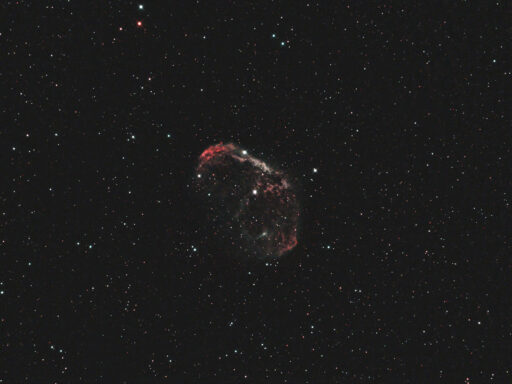
Telescope: Astro-Tech 8” f/8 Ritchey-Chretien, Orion Atlas EQ-G
Camera: Canon EOS Ra, Baader Mk III MPCC, Radian Triad Ultra NB Filter
Guide scope: Astro-Tech 60mm, ZWO ASI120MM mini, PHD2
Exposure: 25x240sec, ISO 3200, saved as RAW
Darks: Internal
Flats: 64×1/5sec, sky flats taken at dusk
Average Light Pollution: Red zone, Bortle 8, good transparency, moonlight
Lensed Sky Quality Meter: 17.2 mag/arc-sec^2
Stacking: Mean with a 1-sigma clip.
White Balance: Nebulosity Automatic
Software: Backyard EOS, Deep Sky Stacker, Nebulosity, Photoshop
The Crescent Nebula is an emission nebula, usually a cloud of diffuse interstellar hydrogen set aglow by hot young stars born within it. However, in this case the nebula was made by a single, massive, fiercely energetic Wolf-Rayet star at its core. Some 250,000-400,000 years ago this star ejected its outer surface while it was a red giant, forming the expanding shell of the nebula. As the star collapsed it ejected a fast moving solar wind that is pushing against the slower moving gas in the shell forming a shock front giving the nebula its distinctive shape.

Recent Comments